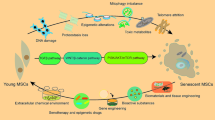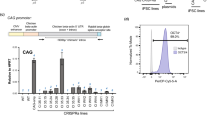Abstract
Pluripotent stem cells within the adipose stromal compartment, termed adipose-derived stromal cells (ASCs), have the potential to differentiate into a variety of cell lineages both in vitro and in vivo. Imaging with expression of exogenous or endogenous green fluorescent protein (GFP) reporters facilitates the detailed research on ASCs’ physiological behavior during differentiation in vivo. This study was aimed to confirm whether ASCs expressing GFP still could be induced to chondrogenesis, and to compare the expression of exogenous or endogenous GFP in ASCs during chondrogenic differentiation. ASCs were harvested from inguinal fat pads of normal nude mice or GFP transgenic mice. Monolayer cultures of ASCs from normal mice were passaged three times and then infected with replication-incompetent adenoviral vectors carrying GFP genes. Allowed to recover for 5 days, Ad/GFP infected ASCs were transferred to chondrogenic medium as well as the ASCs from transgenic mice cultured in vitro over the same passages. The level of GFP in transgenic ASCs maintained stable till 3 months after chondrogenic induction. Whereas, high level of GFP expression in Ad/GFP infected ASCs could last for only 8 weeks and then declined stepwise. Important cartilaginous molecules such as SOX9, collagen type I, collagen type II, aggrecan, collagen type X were assessed using immunocytochemistry, RT-PCR, and Western Blot. The results indicated that no matter the GFP was exogenous or endogenous, it did not influence the chondrogenic potential of ASCs in comparison with the normal controls. Moreover, chondrogenic lineages from ASCs also underwent phenotypic modulation called dedifferentiation as a result of long-term culture in monolayers similar to normal chondrocytes.
Similar content being viewed by others
References
Zuk PA, Zhu M, Mizuno H, Huang J, Futrell JW, Katz AJ, Benhaim P, Lorenz HP, Hedrick MH: Multilineage cells from human adipose tissue: implications for cell-based therapies. Tissue Eng 7(2): 211–228, 2001
Saladin R, Fajas L, Dana S, Halvorsen YD, Auwerx J, Briggs M: Differential regulation of peroxisome proliferator activated receptor gamma1 (PPAR-gamma1) and PPARgamma2 messenger RNA expression in the early stages of adipogenesis. Cell Growth Differ 10(1): 43–48, 1999
Halvorsen YD, Bond A, Sen A, Franklin DM, Lea-Currie YR, Sujkowski D, Ellis PN, Wilkison WO, Gimble JM: Thiazolidinediones and glucocorticoids synergistically induce differentiation of human adipose tissue stromal cells: biochemical, cellular, and molecular analysis. Metabolism 50(4): 407–413, 2001
Fuller JA, Ghadially FN: Ultrastructural observations on surgically produced partial-thickness defects in articular cartilage. Clin Orthop 86: 193–205, 1972
Risbud M, Ringe J, Bhonde R, Sittinger M: In vitro expression of cartilage-specific markers by chondrocytes on a biocompatible hydrogel: Implications for engineering cartilage tissue. Cell Transplant 10(8): 755–763, 2001
Ehlers EM, Fuss M, Rohwedel J, Russlies M, Kuhnel W, Behrens P: Development of a biocomposite to fill out articular cartilage lesions: light, scanning and transmission electron microscopy of sheep chondrocytes cultured on a collagen I/III sponge. Anat Anz 181(6): 513–518, 1999
Milgram JW: Morphologic alterations of the subchondral bone in advanced degenerative arthritis. Clin Orthop 173: 293–312, 1983
Hayes AJ, Benjamin M, Ralphs JR: Extracellular matrix in development of the intervertebral disc. Matrix Biol 20(2): 107–121, 2001
Hutton WC, Ganey TM, Elmer WA, Kozlowska E, Ugbo JL, Doh ES, Whitesides TE Jr: Does long-term compressive loading on the intervertebral disc cause degeneration? Spine 25(23): 2993–3004, 2000
Morales TI, Roberts AB: Transforming growth factor β regulates the metabolism of proteoglycans in bovine cartilage organ cultures. J Biol Chem 263(26): 12828–12831, 1998
van Beuningen HM, Glansbeek HL, van der Kraan PM, van den Berg WB: Differential effects of local application BMP-2 or TGF-β1 on both articular cartilage composition and osteophyte formation. Osteoarthritis Cartilage 6(5): 306–317, 1998
Bianco P, Cossu G: Uno, nessuno e centomila: searching for the identity of mesodermal progenitors. Exp Cell Res 251(2): 257–263, 1999
Iwasaki M, Nakata K, Nakahara H, Nakase T, Kimura T, Kimata K, Caplan AI, Ono K: Transforming growth factor-beta 1 stimulates chondrogenesis and inhibits osteogenesis in high density culture of periosteum-derived cells. Endocrinology 132(4): 1603–1608, 1993
Zuk PA, Zhu M, Ashjian P, De Ugarte DA, Huang JI, Mizuno H, Alfonso ZC, Fraser JK, Benhaim P, Hedrick MH: Human adipose tissue is a source of multipotent stem cells. Mol Biol Cell 13(12): 4279–4295, 2002
Erickson GR, Gimble JM, Franklin DM, Rice HE, Awad H, Guilak F: Chondrogenic potential of adipose tissue-derived stromal cells in vitro and in vivo. Biochem Biophys Res Commun 290(2): 763–769, 2002
Huang JI, Zuk PA, Jones NF, Zhu M, Lorenz HP, Hedrick MH, Benhaim P: Chondrogenic potential of multipotential cells from human adipose tissue. Plast Reconstr Surg 113(2): 585–594, 2004
Denk W, Strickler JH, Webb WW: Two-photon laser scanning fluorescence microscopy. Science 248(4951): 73–76, 1990
Chalfie M, Tu Y, Euskirchen G, Ward WW, Prasher DC: Green fluorescent protein as a marker for gene expression. Science 263(5148): 802–805, 1994
Lippincott-Schwartz J, Patterson GH: Development and use of fluorescent protein markers in living cells. Science 300(5616): 87–91, 2003
Megason SG, Fraser SE: Digitizing life at the level of the cell: high-performance laser-scanning microscopy and image analysis for in toto imaging of development. Mech Dev 120(11): 1407–1420, 2003
Hadjantonakis AK, Dickinson ME, Fraser SE, Papaioannou VE: Technicolour transgenics: imaging tools for functional genomics in the mouse. Nat Rev Genet 4(8): 613–625, 2003
Wakefield LM, Winokur TS, Hollands RS, Christopherson K, Levinson AD, Sporn MB: Recombinant latent transforming growth factor beta 1 has a longer plasma half-life in rats than active transforming growth factor beta 1, and a different tissue distribution. J Clin Invest 86(6): 1976–1984, 1990
Walton PE, Gopinath R, Burleigh BD, Etherton TD: Administration of recombinant human insulin-like growth factor I to pigs: determination of circulating half-lives and chromatographic profiles. Horm Res 31(3): 138–142, 1989
International Guiding Principles for Animal Research: Geneva: Council for International Organization of Medical Sciences, 1985
He TC, Zhou S, da Costa LT, Yu J, Kinzler KW, Vogelstein B: A simplified system for generating recombinant adenoviruses. Proc Natl Acad Sci USA 95(5): 2509–2514, 1998
Bjornsson S: Simultaneous preparation and quantitation of proteoglycans by precipitation with alcian blue. Anal Biochem 210(2): 282–291, 1993
Tanaka H, Murphy CL, Murphy C, Kimura M, Kawai S, Polak JM: Chondrogenic differentiation of murine embryonic stem cells: effects of culture conditions and dexamethasone. J Cell Biochem 93(3): 454–462, 2004
Schwartz NB, Pirok EW III, Mensch JR Jr, Domowicz MS: Domain organization, genomic structure, evolution, and regulation of expression of the aggrecan gene family. Prog Nucleic Acid Res Mol Biol 62: 177–225, 1999
Bayliss MT, Howat S, Davidson C, Dudhia J: The organization of aggrecan in human articular cartilage. Evidence for age-related changes in the rate of aggregation of newly synthesized molecules. J Biol Chem 275(9): 6321–6327, 2000
Knudson CB, Knudson W: Cartilage proteoglycans. Semin Cell Dev Biol 12(2): 69–78, 2001
Watanabe H, Yamada Y, Kimata K: Roles of aggrecan, a large chondroitin sulfate proteoglycan, in cartilage structure and function. J Biochem (Tokyo) 124(4): 687–693, 1998
Sive JI, Baird P, Jeziorsk M, Watkins A, Hoyland JA, Freemont AJ: Expression of chondrocyte markers by cells of normal and degenerate intervertebral discs. Mol Pathol 55(2): 91–97, 2002
Sekiya I, Vuoristo JT, Larson BL, Prockop DJ: In vitro cartilage formation by human adult stem cells from bone marrow stroma defines the sequence of cellular and molecular events during chondrogenesis. Proc Natl Acad Sci USA 99(7): 4397–4402, 2002
Lefebvre V, Huang W, Harley VR, Goodfellow PN, de Crombrugghe B: SOX9 is a potent activator of the chondrocyte-specific enhancer of the pro alpha1 (II) collagen gene. Mol Cell Biol 17(4): 2336–2346, 1997
Dessau W, von der Mark H, von der Mark K, Fischer S: Changes in the patterns of collagens and fibronectin during limb-bud chondrogenesis. J Embryol Exp Morphol 57: 51–60, 1980
Linsenmayer TF, Toole BP, Trelstad RL: Temporal and spatial transitions in collagen types during embryonic chick limb development. Dev Biol 35(2): 232–239, 1973
Poliard A, Nifuji A, Lamblin D, Plee E, Forest C, Kellermann O: Controlled conversion of an immortalized mesodermal progenitor cell towards osteogenic, chondrogenic, or adipogenic pathways. J Cell Biol 130(6): 1461–1472, 1995
Kosher RA, Solursh M: Widespread distribution of type II collagen during embryonic chick development. Dev Biol 131(2): 558–566, 1989
Cheah KS, Lau ET, Au PK, Tam PP: Expression of the mouse alpga1 (II) collagen gene is not restricted to cartilage during development. Development 111(4): 945–953, 1991
Kirsch T, von der Mark K: Remodelling of collagen types I, II and X and calcification of human fetal cartilage. Bone Miner 18(2): 107–117, 1992
Kosher RA, Kulyk WM, Gay SW: Collagen gene expression during limb cartilage differentiation. J Cell Biol 102(4): 1151–1156, 1986
Linsenmayer TF, Eavey RD, Schmid TM: Type X collagen: a hypertrophic cartilage-specific molecule. Pathol Immunopathol Res 7(1–2): 14–19, 1988
Okabe M, Ikawa M, Kominami K, Nakanishi T, Nishimune Y: ‘Green mice’ as a source of ubiquitous green cells. FEBS Lett 407(3): 313–319, 1997
Langer R, Vacanti JP: Tissue engineering. Science 260(5110): 920–926, 1993
Evans CH, Ghivizzani SC, Lechman ER, Mi Z, Jaffurs D, Robbins PD: Lessons learned from gene therapy approaches. Arthritis Res 1(1): 21–24, 1999
Author information
Authors and Affiliations
Corresponding author
Rights and permissions
About this article
Cite this article
Lin, Y., Tian, W., Chen, X. et al. Expression of exogenous or endogenous green fluorescent protein in adipose tissue-derived stromal cells during chondrogenic differentiation. Mol Cell Biochem 277, 181–190 (2005). https://doi.org/10.1007/s11010-005-5996-2
Received:
Accepted:
Issue Date:
DOI: https://doi.org/10.1007/s11010-005-5996-2




